Cervical cancer is one of the main causes of deaths that can be avoided in our society through preventive procedures. Human Papillomavirus (HPV) vaccination and screening are methods included in the Ministry of Health’s plans to reduce the incidence of this type of cancer. Aim. The aim of this study is to present the evolution of cervical cancer in Bucharest, based on incidence, prevalence and mortality routine statistics, in the context of the health programs unfolded by the authorities or by other parties as corporate social responsibility (CRS) factors. Materials and method. This is a correlation between a study and review of the latest literature using data bases on cervical cancer and the prevalence of its risk factors. Results. In Bucharest, it was initiated an awareness program for female population, and in 2008, with the Government support, there was initiated a vaccination program against HPV, but the vaccination rate was under expectations. All these efforts in terms of public funds and the cured persons mobilization did not succeed to change the incidence and the mortality by cervical cancer.
Campaniile de conştientizare privind prevenirea cancerului de col uterin şi efectele acestora asupra populaţiei femeilor din Bucureşti
The awareness campaigns on cervical cancer prevention and their effects in the female population of Bucharest
First published: 20 septembrie 2019
Editorial Group: MEDICHUB MEDIA
DOI: 10.26416/Gine.25.3.2019.2499
Abstract
Rezumat
Cancerul de col uterin este una dintre principalele cauze ale deceselor care pot fi evitate în societatea noastră prin proceduri preventive. Vaccinarea împotriva HPV şi screeningul sunt metode cuprinse în planurile Ministerului Sănătăţii şi au rolul de a reduce incidenţa acestui tip de cancer. Scop. Scopul acestui studiu este prezentarea evoluţiei cancerului de col uterin în Bucureşti, bazată pe statisticile de rutină privind mortalitatea, incidenţa şi prevalenţa, în contextul programelor de sănătate desfăşurate de autorităţi sau de alte părţi ca factor de responsabilitate socială. Materiale şi metodă. Acesta este un studiu/revizuire corelativă, pe baza revizuirii principalelor baze de date privind cancerul de col uterin şi prevalenţa factorilor de risc ai acestuia. Rezultate. În Bucureşti a fost iniţiat un program de conştientizare pentru populaţia feminină, iar în anul 2008, cu sprijinul guvernului, a fost iniţiat un program de vaccinare împotriva HPV, însă rata de vaccinare a fost sub aşteptările iniţiatorilor acestui program. Toate eforturile privind mobilizarea acestor fonduri publice, cât şi mobilizarea persoanelor vindecate nu au reuşit însă să schimbe ratele incidenţei şi mortalităţii cancerului de col uterin.
Background
Cervical cancer is one of the major causes of avoidable deaths in our society. However, more than 530,000 new cases and more than 275,000 deaths occur worldwide every year, according to Globocan 2008(1). Cervical cancer is the second cause of cancer in women, after breast cancer (15.3 cases per 100,000), and the third cause of mortality, after breast and lung cancers (7.8 deaths per 100,000).
In Romania, the importance of this public health problem is huge, cervical cancer being responsible for 3400 new cases of disease and around 2000 deaths every year, with an incidence and mortality rate higher than global average (23.9 and 11.8, respectively). The disparities are even larger compared to WHO European Region, where cervical cancer is the fifth cause of incidence (10.1/100,000, after breast, colorectum, lung and corpus uteri cancer) and the seventh cause of mortality (3.9 deaths/100,000 females) or especially to EU region (Figure 1).
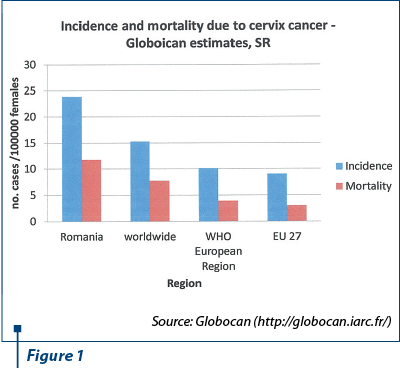
According to what we know, cervical cancer can be prevented or cured if the diagnose is established in an early stage. Cytology screening every three to five years can prevent up to four out of five cases of cervical cancer, but such benefits can only be achieved if screening is provided in organized, population-based programs and with quality assurance at all levels.
A World Health Organization (WHO) guideline for cancer control has established there are two main strategies for the early detection: early diagnosis, involving patients’ awareness about the signs and symptoms of the disease, leading to a consultation with a medical provider who promptly refer the patient to specialized services, or population screening of asymptomatic females to detect pre-cancerous lesions or an early stage of cancer(2).
Materials and method
This study is a review of the evolution of cervical cancer in Bucharest (the capital of Romania) on the background of the preventive interventions meant to create awareness among female population. Many awareness campaigns were developed in Bucharest, targeting especially the adult female population, but also the young girls. These interventions presented the magnitude of cervical cancer impact on the personal health, the potential to avoid or to cure this disease in certain conditions, and the individual choices to keep the reproductive health for a female. They were financed part by the Ministry of Health, part by the economic sector as part of the corporate social responsibility (CSR). In 2008, a vaccination program against Human Papillomavirus was started (with the Government support), but the vaccination rate was much lower than expected. Furthermore, during all these years, a screening program for cervical cancer was also financed by the Government, but unfortunately this program was opportunistic, not population based.
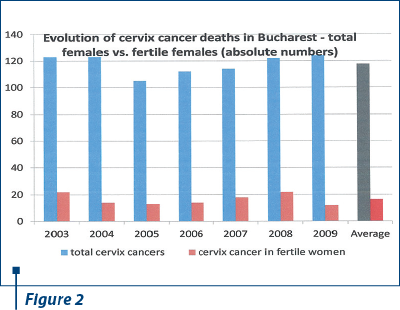
All these efforts in terms of public funds and health providers mobilization did not succeed to change the incidence and the mortality by cervical cancer. The lowest number of deaths due to cervix cancer was registered in 2005 and there has been a steady small increase ever since.
Cervix cancer seemed to be a more serious burden of death in fertile women (Figure 3).
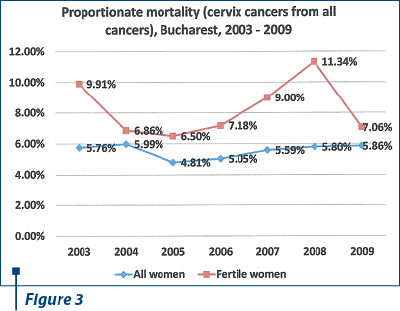
The number of women in Romania was higher than that of men in 2012.
In Romania, in 2012, there were registered 19 million people with stable residence in the country. Of this total, women were 9.7 million. Thus, in 2012, the female population represented 51.3% of the stable population, slightly increasing compared to 2002, when the female population accounted for 51.25% of the total stable population.
Today there are 900,552 women living in the capital, less than in 2002 when more than a million women lived here(3).
The role of the midwife or nurse in the relationship with the patient
The role of the nurse is to help people in a state of illness to maintain and regain their health by performing the duties they could have performed alone if they had the strength, determination and useful knowledge. The medical assistant must perform his functions in order to help the patient overcome the deadlock and regain his independence according to the affected need.
These functions can be of an independent nature when assisting the patient on his own initiative through comfort care, depending on the physical or mental illness, social status, age, problems that he cannot handle himself; establishes trusting relationships with the patient and caregivers, listens to the patient and tries to support him by providing useful information. By the dependent function, the medical assistant acts only at the doctor’s notice, observing the patient’s evolution according to the changes caused by the disease, applying the treatment and the methods of rehabilitation, transmitting to the doctor any changes(4).
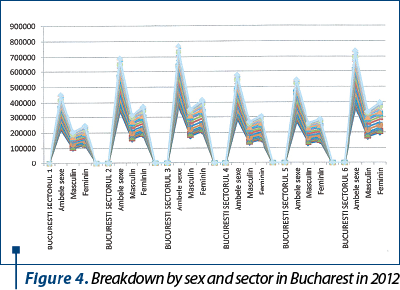
The health education that the nurse gives to the patients is about signs that may appear in the evolution of the beginning phases or during the evolution of the disease, these having an important role and the patients must know about them.
These signs in particular are important for patients from rural areas or for patients who do not regularly attend medical investigations and who must recognize a serious condition in order to benefit from urgent medical care.
As methods of educating the female population, the nurse instructs them to recognize the following signs and symptoms: leukorrhea, which in cancer is present and usually occurs before bleeding, and which may have the appearance of a flesh wash and characteristic odor.
We, the nurses, inform the patient that the pain in advanced forms of cancer can be intermittent or continuous and may manifest as a tension or embarrassment in the lower abdomen accompanied by fever, nausea and even vomiting.
Other signs that may appear are bleeding, which, depending on the tumor, have specific characteristics. In cervical cancer, more precisely, it is represented by reduced bleeding quantitatively at sexual contact or after intravaginal washes.
Other manifestations in neoplasms are weight loss, polakiuria, dysuria and nocturia, and in ovarian and uterine cancer, intestinal colic, rectal tenesmus and constipation.
The nurse’s aim is that the patient know and understand the importance of periodic medical check-up, accept the diagnosis, know the technique of investigations, and accept its limitations. Having a normal couple’s life is important for the patient’s psychic and also to accept his/her body.
Interventions of the midwife or nurse in the cervical cancer patient
The nurse advises the patient to come periodically to the gynecological check-up for an early detection of the disease.
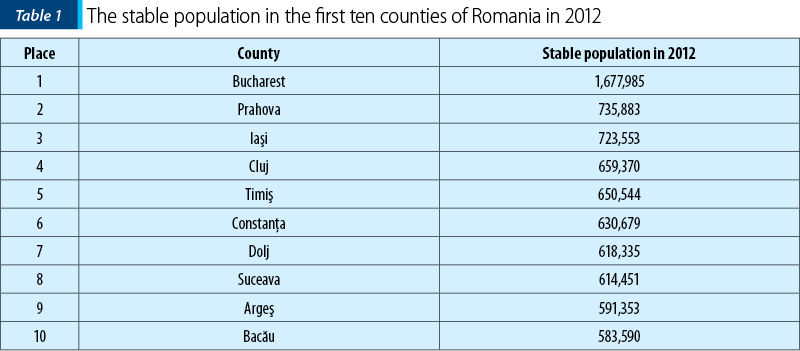
In order to reduce the fear and anxiety related to the operation, the nurse tries to win the patient’s confidence, encourages and accompanies her when the investigations are carried out, helps the patient to accept the operation, facilitates the presence of the family or of significant others for the patient, helps the family members to understand the psychological state and the patient’s need for help, makes time to stay with the patient and to observe the reactions. The nurse provides postoperative surveillance to prevent complications.
The nurse also explains the doctor’s recommendations made at the hospital regarding local hygiene and medical control, avoiding sexual intercourse for 4-8 weeks, and continuing the recommended treatment (chemotherapy, radiotherapy, hormone therapy).
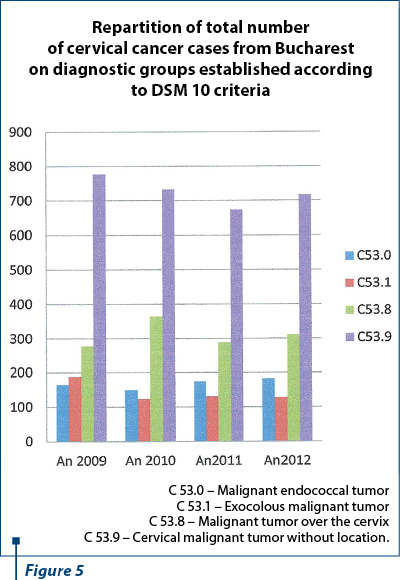
The nurse advises the patient for problems that may arise, regarding anxiety, fear of surgery, possible alteration of the sexual activity produced by treatment, decreased libido and loss of self-esteem caused by the mutilating operations (hysterectomy, anexectomy)(5).
Within the preventive procedures associated with health education, the methods that can be applied to a large population are HPV screening and vaccination. These methods are included in the plans of the Ministry of Health to reduce the incidence of this type of cancer.
At present, there are known over 100 strains, and we mention those with potential oncogenic risk (16, 18, 31) and the non-oncogenic strains (6, 11)(6).
Studies linking HPV to 99.7% of the cervical cancers have shown the relationship between HPV and cervical cancer. In order to ensure a sufficient duration of specific antibodies and the protection of each body against HPV infection, the vaccination is performed at the age of 11-13 years old, before the beginning of sexual life, in order to reduce the rate of cervical cancer development in the future(7).
In a final comprehensive look, we note the key importance of the nurse involved in these health programs. The professional training of the licensed midwives and assistants confers the solidity of the information they transmit to the patients and professionalism in the application of the programs of the Ministry of Health in the fight against cervical cancer.
The emphasis in the vocational training of these preventive programs during the faculty brings a clear benefit in reducing the risk of cervical cancer.
In my professional practice, I encountered this situation in the disadvantaged Rroma and rural communities, which reinforced my conviction and the need to present this situation and to find the methods of solving it.
Conflict of interests: The author declares no conflict of interests.
Bibliografie
- http://moldova.unfpa.org/sites/default/files/pub-pdf/Cervical%20Cancer_Issue5_rom.pdf
- https://www.dspsv.ro/uploads/PromovareaSanatatii/Saptamana%20Cancerului%202019/Analiza%20SELIC.pdf
- http://www.gandul.info/stiri/recensamant-2012-harta-noii-romanii-9978083
- Titircă L (coord.), Gherghinica G, Dorobanţu E. Tehnici de evaluare şi îngrijiri corespunzătoare nevoilor fundamentale. Editura Viaţa Medicală Românească, Bucureşti, 2008; Ed. 7, vol. 1:15-6.
- Titircă L, Dorobanţu D, Gherghinica G, Seuchea M. Îngrijiri speciale acordate pacienţilor de către asistenţii medicali: Manual pentru colegiile şi scolile postliceale, Editura Viaţa Medicală Românească, Bucureşti, 2008; Ed. 9, 178-80.
- Popescu D. Infecţiile cu transmitere sexuală. Editura Universitară „Carol Davila”, Bucureşti, 2010; 103-4.
- http://www.ecca.info/ro/saptamana-de-prevenire-a-cancerului-de-col-uterin/saptmana-de-prevenire-a-cancerului-de-col-uterin/-
Articole din ediţiile anterioare
Progesteron, vitamine, metformin şi aspirina administrate în sarcină - „mit” sau medicină bazată pe dovezi?
Deşi sarcina este o stare fiziologică normală şi naşterea este un fenomen natural, posibilele complicaţii ale acestora, deşi rare, sunt suficient d...
Strategii de prevenire a preeclampsiei. Farmacocinetica şi farmacodinamica heparinelor cu greutate moleculară mică în sarcină
Preeclampsia este o boală caracteristică numai sarcinii umane, având ca unică metodă de vindecare naşterea. Morbiditatea şi mortalitatea asociate a...
Analiza rezultatelor programelor naţionale de screening pentru depistarea activă precoce a cancerului de col uterin şi propunere de strategie
În cazul tuturor tipurilor de cancer, este universal valabil faptul că detectarea precoce îmbunătăţeşte semnificativ rata de supravieţuire.
Actualităţi asupra ghidurilor internaţionale privind screeningul cancerului cervical
Cancerul de col uterin afectează în principal femeile din ţările în curs de dezvoltare, incidenţa şi ratele mortalităţii sale fiind strâns legate d...